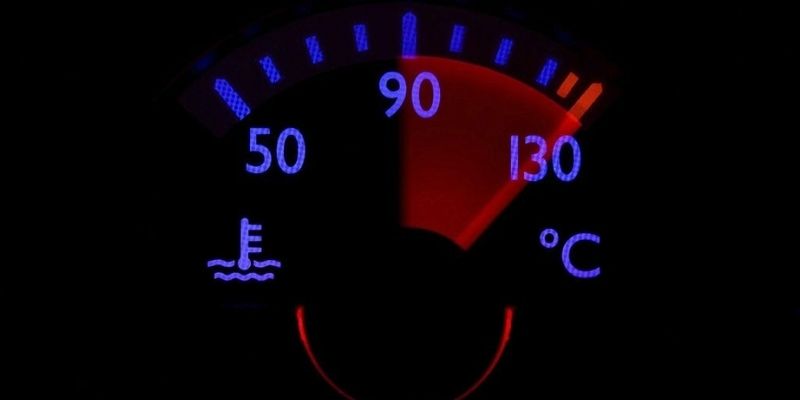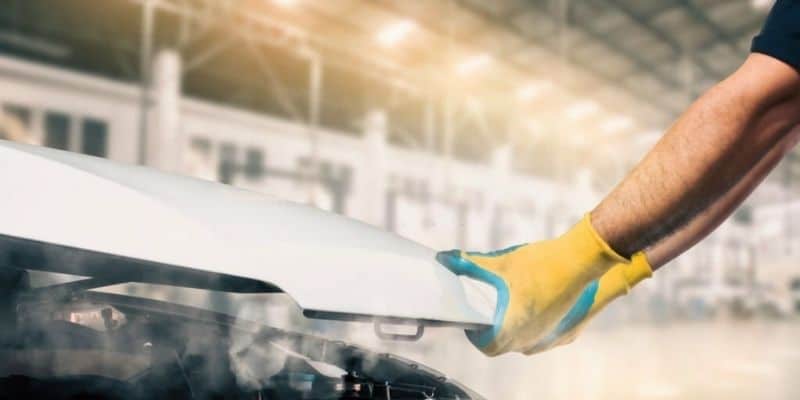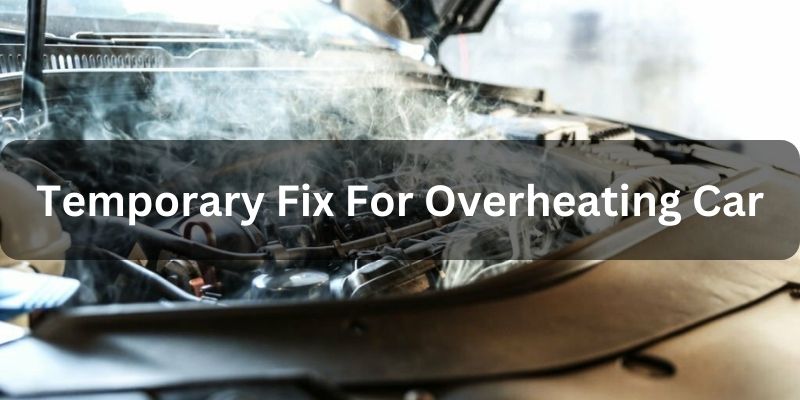Car overheating is an unwelcome and potentially dangerous situation that can occur at the most inconvenient times. When your vehicle’s temperature gauge begins to climb beyond its usual range, smoke starts emerging from under the hood.
This article guides you to understanding the causes and symptoms of car overheating and provides practical solutions to stay safe on the road.
In the article, we will explore the common cause and temporary fix for overheating cars to keep your vehicle moving while maintaining your vehicle’s well-being. In addition, you will get to know the symptoms of the car overheating so you get to know the overheating engine before any serious damage to the car’s engine.
Symptoms of Car Engine Overheating
1. Rising Temperature Gauge
The rising engine temperature gauge on your car’s dashboard is one of the first indicators of potential overheating. This crucial instrument monitors the engine’s temperature, and when it starts to climb beyond the normal range, it signals trouble.
When you observe the temperature gauge rising towards the “hot” zone or moving into the red, it’s a clear symptom of low coolant. In such a situation, it’s necessary to take immediate action to prevent further damage.
Ignoring the engine overheating can lead to severe engine issues, including head gasket damage and warped cylinder heads, resulting in costly repairs. To address a rising temperature gauge, it’s essential to pull over safely, turn off the engine, and allow it to cool down.
2. Smoke from the Engine
Smoke coming out of the engine compartment is a major and distressing sign that your vehicle is under overheating issues. This occurrence often accompanies an elevated temperature gauge on your dashboard, serving as a visual confirmation of the problem.
The smoke is typically a result of coolant or engine oil reaching temperatures beyond their limits. When this happens, the fluid can vaporize, creating plumes of smoke that escape from under the hood. It’s a clear indication that immediate action is required to prevent further damage to your engine.
When you observe smoke, it’s crucial to pull over to a safe location and turn off the engine. Stop the car and wait until the engine gets cold. After the engine has cooled, check for any visible signs of coolant or oil leaks, as these may have contributed to the overheating.
3. Dashboard Warning Lights
Dashboard warning lights play a pivotal role in alerting you to potential problems, including car overheating. When your engine begins to exceed safe operating temperatures, a specific warning light will appear on your dashboard.
This warning light is the primary indication that the engine is running too hot, and coolant is boiling in the radiator. Ignoring it can lead to severe consequences, making it crucial to respond promptly.

When the overheating warning light appears, it’s important to take immediate steps to address the issue. Begin by pulling over to a safe location, turning off the engine, and allowing it to cool down. This precautionary measure can prevent further damage to engine components.
Afterward, check the coolant level and assess for any visible signs of coolant leakage or engine damage. Keep in mind that addressing the issue early can save you from costly repairs and ensure your safety on the road.
4. Reduced Engine Performance
Car overheating not only impacts your cooling system but also leads to a significant reduction in engine performance. As the engine’s temperature climbs, its efficiency decreases, resulting in the car jerking when acceleration, diminished power output, and potential engine misfires.
When you experience reduced engine performance, it’s crucial to recognize it as a potential symptom of overheating and respond promptly. Continuing to drive with an overheating engine can worsen the issue, leading to more extensive damage.
To address reduced engine performance due to overheating, begin by safely pulling over to the side of the road and turning off the engine. Allowing the engine to cool down is essential. Once it has cooled, check the coolant and if it’s low, fill the coolant to its recommended level.
Temporary Fixes for Overheating Car
Turning Off the Air Conditioning
When faced with an overheating car, one of the immediate and effective actions you can take is to turn off the air conditioning (A/C). Turning off the car A/C will give relief to the engine by exempting the power it was consuming and the heat generated during the process.
By deactivating the A/C, you reduce the load on the engine, allowing it to divert its resources toward cooling down. This can be a crucial step in preventing further overheating and potential engine damage.
To turn off the A/C, simply locate the A/C button or switch on your dashboard and disengage it. Some vehicles may also have a “Max A/C” setting that you should avoid using when the engine is already running hot.
Using the Heater
Turning on the heater activates the car’s interior fan, which, in turn, dissipates excess heat from the engine. While this may make the interior uncomfortably warm, it’s a small trade-off for the engine’s well-being.
To employ this strategy, set your heater to its highest temperature and fan speed, directing the airflow toward the vehicle’s interior. This process helps redirect some of the heat away from the engine, thereby reducing its temperature.
Remember that this is a short-term solution and won’t address the root cause of the overheating issue. It’s vital to pull over to a safe location, turn off the engine, and allow it to cool down. Afterward, you can investigate the cause of the overheating, such as low coolant or a malfunctioning thermostat.
Turning Off the Engine
When your car’s temperature gauge comes into the danger zone, and signs of overheating are evident, one of the most critical actions to take is turning off the engine. While it may seem like a straightforward step, its significance cannot be overstated.
Shutting off the engine serves two essential purposes:
- Immediate Cooling: An idling engine generates heat, even when it’s overheating. By turning off the engine, you halt this heat production and allow the components to cool down more rapidly.
- Preventing Damage: Overheating can cause severe engine damage, including warped cylinder heads and blown gaskets. Turning off the engine can prevent these costly consequences.
To execute this step effectively, safely pull over to the side of the road or a parking lot. Ensure the vehicle is in “Park” or in gear with the parking brake engaged. Once the engine is off, pop the hood carefully if you feel it’s safe to do so.
Checking and Topping Up Coolant
Low coolant level is one of the primary causes of car overheating. When coolant levels drop below the recommended mark, the engine struggles to stay within its optimal temperature range.
To address this issue, you can perform a simple but crucial step: checking and topping up the coolant.
Here’s how:
- Allow the Engine to Cool: Before attempting to check or add coolant, ensure the engine has cooled down. Opening the radiator or coolant reservoir cap when the engine is hot can result in severe burns from escaping steam.
- Locate the Coolant Reservoir: Most vehicles have a translucent plastic coolant reservoir located near the engine. Check the side of the reservoir to see the current coolant level.
- Check the Level: The coolant level should be between the “MIN” and “MAX” marks on the reservoir. If it’s below the “MIN” mark, it’s essential to add more coolant.
- Add Coolant: To top up the coolant, choose the best coolant compatible with your car. Use a mixture of coolant and water in the correct ratio (usually 50:50). Slowly pour the coolant mixture into the reservoir until it reaches the “MAX” mark.
- Check the Radiator Cap: Some vehicles may have a radiator cap directly on the radiator. If so, you can check and top up the coolant at this point. However, exercise caution, as the radiator cap can release hot steam when opened.

By maintaining the proper coolant amount, you ensure that the engine’s cooling system functions optimally, reducing the risk of overheating. Remember that this is a temporary fix, and addressing the root cause of the overheating is essential for long-term vehicle health.
Adding Water
When dealing with an overheating car and lacking access to coolant, water can serve as a temporary solution. While not as effective as coolant, water can help dissipate some of the engine’s excess heat.
Here’s how to add water effectively:
- Engine Cool-Down: Ensure the engine has cooled down before attempting any intervention. Opening the radiator when the engine is hot can be dangerous.
- Identify the Reservoir: Locate the coolant reservoir or radiator. The coolant reservoir typically has “MIN” and “MAX” marks to indicate the appropriate level.
- Check the Coolant Level: Inspect the coolant level; if it’s below the “MIN” mark, it’s a sign that you should add water.
- Add Water Slowly: Use a funnel to pour clean, distilled water into the reservoir or radiator until it reaches the “MAX” mark. It’s crucial not to overfill.
- Start the Engine: After adding water, start the engine and allow it to run briefly. This will help distribute the water throughout the cooling system.
Remember that water is a temporary coolant alternative and should be replaced with the proper coolant mixture as soon as possible. While water can help manage if the car is overheating in the short term, it lacks the anti-freeze and anti-corrosion properties of coolant.
Pop the Hood
When your car shows signs of overheating, opening the hood is a crucial step in assessing the situation. This action allows you to visually inspect the car engine compartment to visualize the actual smoke emerging portion of the engine.
Here’s what you should do:
- Safety First: Ensure your vehicle is safely parked in a designated area away from traffic. Turn off the engine, engage the parking brake, and wait until the engine cools down.
- Locate the Hood Release Lever: In most vehicles, the hood release lever is located inside the cabin, typically beneath the dashboard near the driver’s seat.
- Release the Hood: Pull the hood release lever to release the hood latch. Exit the vehicle and go to the front of the car.
- Lift the Hood: Open the hood gently while supporting it with the provided prop rod or hydraulic struts, if equipped. Avoid excessive force to prevent damage.
- Inspect the Engine Compartment: With the hood raised, visually inspect the engine compartment for any visible signs of coolant leaks, loose or disconnected hoses, or broken belts. Pay attention to any steam or smoke, as these are clear indicators of car overheating.

By taking this step, you can identify any obvious issues that may be contributing to the overheating problem. However, exercise caution, as the engine and surrounding components may still be hot.
Turn Off Non-Essential Electronics
One effective way to do this is by turning off non-essential electronics within your vehicle. While these electronic features add comfort and convenience, they also draw power from the engine, which can contribute to overheating.
Here’s what you should consider turning off:
- Air Conditioning (A/C): The A/C system places a substantial load on the engine, so switching it off can help reduce heat generation.
- Heated Seats: If your vehicle is equipped with heated seats, deactivating them can help conserve power.
- Stereo and Infotainment Systems: While it may seem minor, turning off the stereo and infotainment systems can reduce the electrical load on the alternator, which is driven by the engine.
- Exterior Lights: If driving during daylight or in well-lit areas, consider turning off your vehicle’s exterior lights, such as fog lights or daytime running lights.
By minimizing the use of these non-essential electronics, you allow your engine to focus on cooling down and managing the overheating situation.
When to Seek Professional Help for Overheating Car?
Seek mechanic help for car overheating if:
- Overheating Persists: If the problem persists after attempting temporary fixes.
- Repeated Overheating: If your vehicle consistently overheats, even after cooling down.
- Visible Damage: If you observe visible damage, leaks, or unusual engine noises.
- Loss of Coolant: If there’s a continuous loss of coolant without an apparent cause.
- Warning Lights: If warning lights indicate engine issues.
- Lack of Repair Knowledge: If you’re unsure about the cause or unable to resolve the problem yourself.
Emergency Supplies for Overheating Situations
Essential emergency supplies for overheating situations include:
- Coolant: Carry extra coolant in your vehicle’s emergency kit.
- Water: Keep a supply of clean, distilled water for coolant top-ups.
- Gloves: Protect your hands when handling hot engine components.
- Funnel: Use a funnel for safe coolant or water pouring.
- Basic Tools: Include basic tools like pliers and a screwdriver for potential repairs.
- Flashlight: A flashlight is essential for night-time emergencies.
- Emergency Contact: Have contact information for roadside assistance or a trusted mechanic.
Frequently Asked Questions (FAQs)
What causes a car engine to overheat?
Car overheating can be caused by various factors, including:
- Low Coolant Levels: Inadequate coolant in the radiator can disrupt the engine’s cooling process.
- Faulty Thermostat: A malfunctioning thermostat can impede the flow of coolant, leading to temperature spikes.
- Coolant Leaks: Any leaks in the cooling system, such as from hoses, the radiator, or the water pump, can result in coolant loss.
- Blocked Radiator: Accumulated debris, dirt, or contaminants can obstruct the radiator’s ability to dissipate heat.
- Broken Belts or Hoses: Damaged serpentine belts or radiator hoses can lead to coolant circulation issues.
- Stuck Cooling Fans: Cooling fans that fail to engage can disrupt the cooling process.
- Faulty Water Pump: A malfunctioning water pump may hinder the circulation of coolant.
- Engine Overload: Excessive loads on the engine, such as towing or steep climbs, can generate excess heat and the car may stall while driving.
- Clogged Radiator Cap: A clogged or malfunctioning radiator cap can impede the release of pressure, affecting coolant flow.
- Engine Misfires: Engine misfires can cause irregular combustion, generating additional heat.
Understanding these potential causes is essential in diagnosing and addressing car overheating issues promptly.
Is it safe to drive with an overheating car?
Driving with an overheating car is not safe. It can lead to severe engine damage and potentially dangerous situations. Overheating should be addressed immediately by pulling over, turning off the engine, and allowing it to cool down.
How can I prevent car overheating in the future?
To prevent car overheating:
- Regular Maintenance: Maintain proper coolant levels and schedule routine maintenance.
- Check Hoses and Belts: Inspect and replace damaged hoses and belts.
- Monitor Temperature: Keep an eye on your temperature gauge while driving.
- Avoid Overloading: Avoid excessive loads or aggressive driving in hot conditions.
- Service Cooling System: Service the cooling system as recommended by your vehicle’s manufacturer.
Conclusion
Car overheating can strike unexpectedly, but being equipped with temporary fixes can mitigate the situation. Understanding the potential causes, from low coolant levels to malfunctioning components, empowers you to take swift action.
Whether it’s topping up coolant, using the heater strategically, or turning off non-essential electronics, these measures offer immediate relief. However, they serve as temporary remedies and should be followed by a thorough diagnosis of the root cause.
By recognizing the signs, employing these quick solutions, and staying alert, you can navigate overheating incidents with confidence.

Joseph Morgan has decades of automotive experience. The Detroit native started restoring classics in the 1970s. He owned a vintage repair shop and authored articles for car magazines. With a 1965 Mustang fastback of his own, Joseph now shares advice through his YouTube channel. From engine swaps to rust repair, his expertise helps preserve automotive history.
